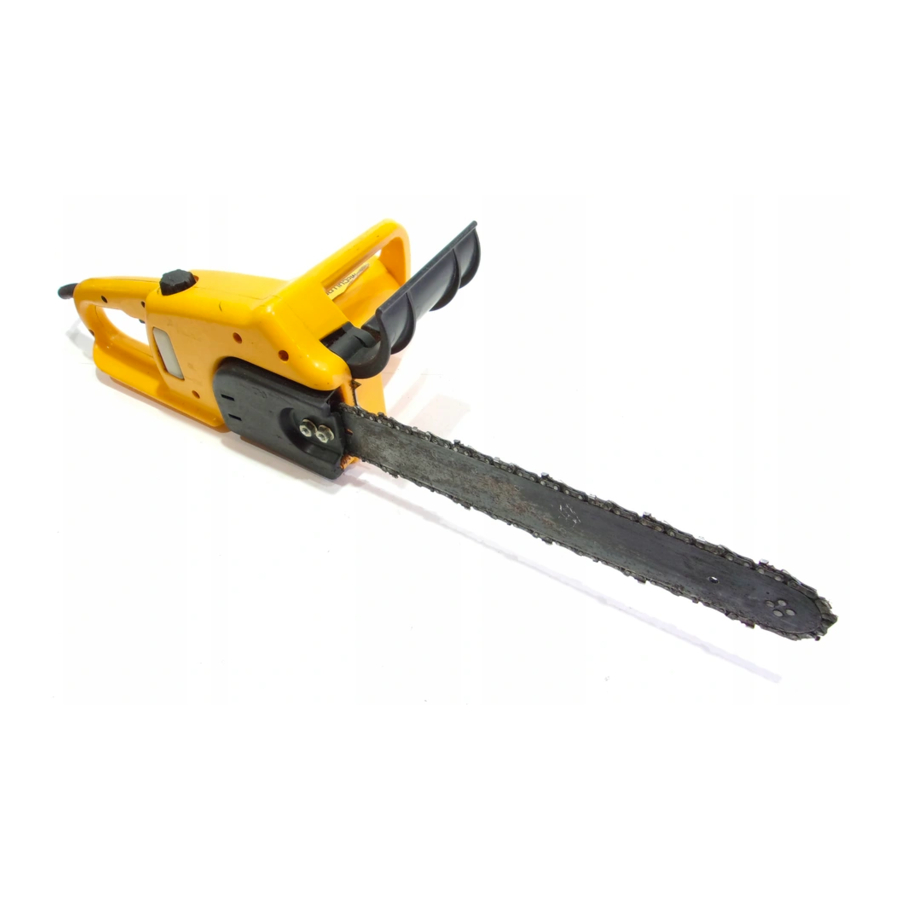Summary of Contents for McCulloch Electramac 1650-14
- Page 1 Husqvarna Outdoor Products Italia SpA Via Como 72 23868 Valmadrera (Lecco) ITALIA Phone + 39 0341 203111 - Fax +39 0341 581671 PN. 249498 REV. 05 (01/06)
- Page 4 Rear handle Rear hand guard Front handle Front hand guard/chain brake lever Chain tensioner knob/screw Chain tensioner pin Oil tank cap Oil tank inspection gauge Air vents Cable Manual Switch Switch block Chain Drive tooth Cutting link LEGEND: Guaranteed noise level according to directive 2000/14/EC Double insulation CE marking of conformity...
- Page 6 reference number of the corresponding component to draw the reader’s attention to the main safety procedure linked with that particular situation; the machine parts shown in “A DESCRIPTION” are indicated in italics in the text for easy identification. Precautions prior to machine use. Never permit this machine to be used by any persons who are not perfectly familiar with the manual instructions, who are not in good physical and mental condition, who...
- Page 7 6. Health precautions – Chemical agents. Avoid all chain oil contact with skin and eyes. 7. Health precautions - Electricity. All extension cords, plugs, and electricity lines must be homologated, to standard and in compliance with current regulations. Make sure that the main line to which the machine is connected is equipped with a residual current device (RCD) with a current capacity no higher than 30mA.
- Page 8 sure that the cable/ extension cord is kept behind the user, controlling that it does not create a source of danger for the user or for other persons, and check that it cannot be damaged (by heat, sharp objects, sharp edges, oil, etc); Always assume a stable standing position on both legs;...
- Page 9 The chain brake can be activated in two modes: the first using the left wrist by pushing forwards, or when it comes into contact with the brake system as a result of kickback; or by inertia, in the case of particularly violent kickback.
- Page 10 case do not tighten the chain immediately after use, but wait until it cools down. In cases where the loosened chain needs to be adjusted, always unscrew the bar retaining nuts / knob before adjusting the chain tensioning screw/knob ; adjust the tension and tighten the bar retaining nuts /knob accordingly.
- Page 11 Check that the chain is sharpened correctly (See below), in good working condition and that the tension is correct. If the chain is irregularly worn, or if the cutting teeth are only 3 mm high, the chain must be replaced(fig.3). Clean the air vents regularly to prevent motor overheating.
- Page 12 - At the end of each cutting operation the user will notice a considerable change in the strength necessary for controlling the machine. Great care must be taken not to loose control . Below is a description of two different types of cutting operation: Cutting action by pulling the chain (from top to bottom) (fig.2) can lead to dangerous sudden...
- Page 13 and lower cut. The meeting point between the two sides of the notch is called “directional cut line” This line must be perfectly horizontal at right angles (90°) to the felling direction. The felling cut that provokes the tree fall, is performed at 3 to 5 cm above the lower part of the directional felling cut line, finishing at a distance of 1/10 of the trunk from the notch.
- Page 14 M. TROUBLESHOOTING TABLE chain brake chain...
- Page 15 The undersigned, authorized by H.O.P.I., declares that the following products model: type ES15, ES 15/1, ES 15/2, ES16, ES 16/1, ES18 starting from 2004 onwards, manufactured by H.O.P.I., Valmadrera, Italy, comply with European Directive: 98/37/EEC (Machine Directive), 93/68/EEC (EEC Marking Directive) & 89/336/CEE (Electromagnetic Compatibility Devices), directive 2000/14/EEC (Enclosure V).













Need help?
Do you have a question about the Electramac 1650-14 and is the answer not in the manual?
Questions and answers